 |
Chris Bell | 'All I ask for is the chance to prove that money can't make me happy.' |
| - Spike Milligan |
 |
Chris Bell | 'All I ask for is the chance to prove that money can't make me happy.' |
| - Spike Milligan |
You will stay on this website. Do not refresh your browser, or you will have to visit Changelly.com to see your exchange progress.
Shortcut Scroll-Down Menu
Litecoin (LTC or Ł) is a peer-to-peer cryptocurrency and open source software project released under the MIT/X11 license. Creation and transfer of coins is based on an open source cryptographic protocol and is not managed by any central authority. Litecoin was an early bitcoin spinoff or altcoin, starting in October 2011.[7] In technical details, litecoin is nearly identical to Bitcoin.

Litecoin was released via an open-source client on GitHub on October 7, 2011 by Charlie Lee, a Google employee and former Engineering Director at Coinbase. The Litecoin network went live on October 13, 2011. It was a fork of the Bitcoin Core client, differing primarily by having a decreased block generation time (2.5 minutes), increased maximum number of coins, different hashing algorithm (scrypt, instead of SHA-256), and a slightly modified GUI. During the month of November 2013, the aggregate value of Litecoin experienced massive growth which included a 100% leap within 24 hours. Litecoin reached a $1 billion market capitalization in November 2013. In May 2017, Litecoin became the first of the top 5 (by market cap) cryptocurrencies to adopt Segregated Witness. Later in May of the same year, the first Lightning Network transaction was completed through Litecoin, transferring 0.00000001 LTC from Zürich to San Francisco in under one second.
Litecoin is different in some ways from Bitcoin:
Due to Litecoin's use of the scrypt algorithm, FPGA and ASIC devices made for mining Litecoin are more complicated to create and more expensive to produce than they are for Bitcoin, which uses SHA-256.
https://en.wikipedia.org/wiki/Litecoin

What is Litecoin? A Basic Beginners Guide. Litecoin has taken the world by storm.
As more and more people are embracing the world of cryptocurrency, people are looking for investment opportunities outside of Bitcoin and Ethereum. Litecoin clearly looks like a popular choice.
Consider this: The price of litecoin has increased by 7,291% from the beginning of 2017! In comparison, bitcoin “only” increased by 1731%.
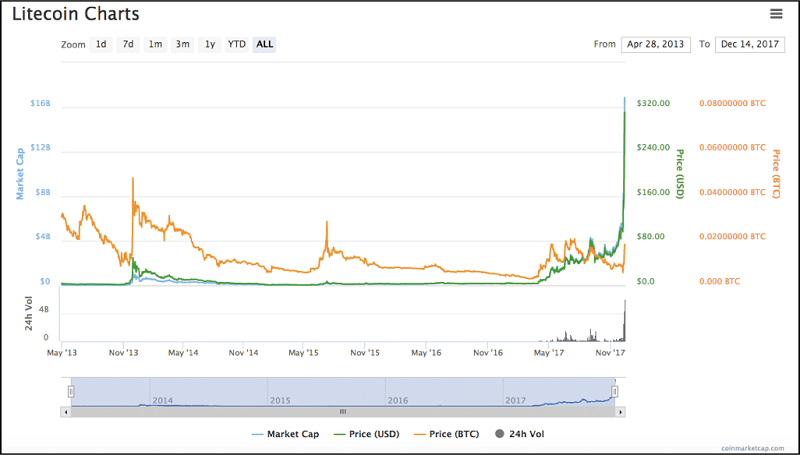
Image by Coin Market Cap
That graph is scary!
Anyway, in this guide, we are going to do a deep dive on litecoin. Let’s take a peek underneath the hood and see how it functions.
While the identity of the Bitcoin creator Satoshi Nakamoto is shrouded in mystery, Litecoin’s creator Charlie Lee is very active on social media and his blog. Charlie Lee is an ex-Google employee who had the vision to create a lighter version of Bitcoin.

While Bitcoin was seen as "gold" and a store of value for long-term purposes, Litecoin was seen as the "silver" and a means of a transaction for cheaper and everyday purposes. So, on October 7 2011, litecoin was released via an open-source client on GitHub. The Litecoin Network went live on October 13 2011. It is basically a fork of the Bitcoin Core client.

Image by Coindesk
If we are to truly understand Litecoin, comparisons with Bitcoin is a must. Litecoin, by their own admission, is a clone of Bitcoin. So, what are some of the fundamental differences that set it apart from bitcoin? Let’s explore them one by one.
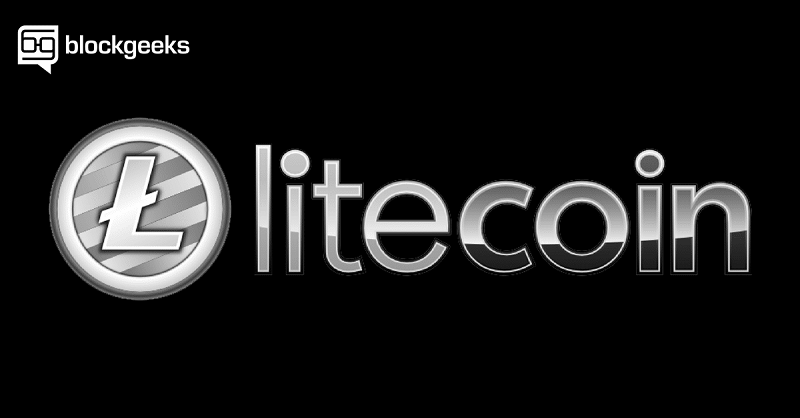
One of the most fundamental and technical differences between the two is their mining procedure. Both use Proof-of-work consensus mechanism. Proof-of-work is pretty straightforward to understand. The miners use their computational power to solve extremely hard cryptographic puzzles. The puzzle solving needs to be extremely hard, if it is simple then miners will keep mining blocks and drain out the entire bitcoin supply. However, while the puzzle solving part is difficult, checking to see if the solution of the puzzle is correct or not should be simple.
And that, in a nutshell, is proof of work.
Now, both bitcoin and litecoin go about this a little differently. Bitcoin uses the SHA-256 hashing algorithm for its mining purposes. Before long, miners discovered that they could exponentially increase their mining power by joining together and forming mining pools via parallel processing.
In parallel processing, program instructions are divided among multiple processors. By doing this, the running time of that program decreases greatly and that is basically what the mining pools are doing. The SHA 256 puzzles require a lot of processing power, and that gave rise to specialized “application-specific integrated circuits aka ASICs. The only purpose that these ASICs served was bitcoin mining.
These mining pools would basically have an entire powerplant of ASICs designed specifically for bitcoin mining.

Image Credit: Digiconomist

Image Credit: Digiconomist
Along with this, the effects that it can have on the environment is potentially very devastating.
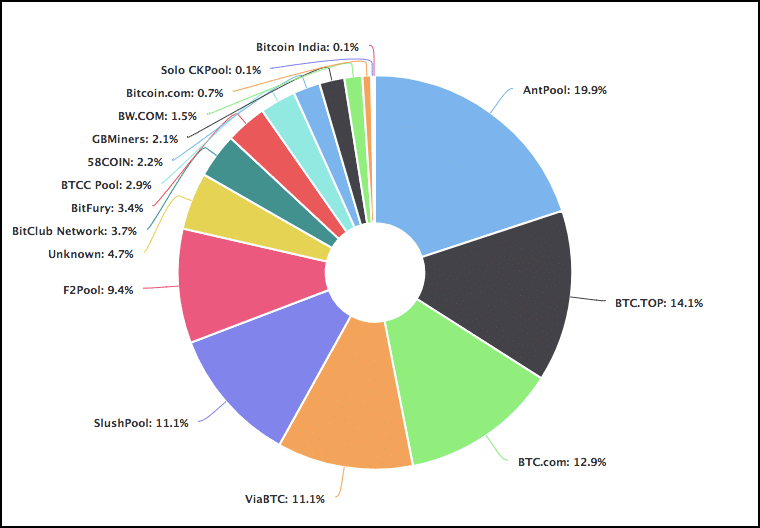
Image Credit: Blockchain.info
As of right now, more than 50% of bitcoin’s hashrate is used up by 5 mining pools alone!If a pool ever manages to get 51% hashrate, then they can launch a 51% attack on the blockchain.
So, to combat these issues, Litecoin uses the Scrypt algorithm.
Scrypt was originally named “s-crypt” however it is pronounced as “script”. While this algorithm does, in fact, utilize the SHA 256 algorithm, its calculations are way more serialized than the SHA-256 in bitcoin. As such, parallelizing the calculations is not possible.
What does this mean?
Suppose we have two processes A and B. In bitcoin, it will be possible for the ASICs to do A and B together at the same time by parallelizing them. However, in Litecoin, you will need to do A and then B serially. If you try to parallelize them, the memory required becomes way too much too handle. Scrypt is called a “memory hard problem” since the main limiting factor isn’t the raw processing power but the memory. This is specifically the reason why parallelization becomes an issue. Running 5 memory hard processes in parallel requires 5 times as much memory. Now, of course there can be devices manufactured with tons of memory in it, but two factors mitigate this effect:
Scrypt has been deliberately designed to make sure that mining is accessible and democratized as possible. However, recently companies like Zeus and Flower Technology have managed to create Scrypt ASICs. This would, unfortunately, mean the demise of their dream of democratized mining.
Average block mining speed in Litecoin is 2.5 mins when compared to bitcoin’s 10. This graph shows the block creation time for litecoin:

Image Credit: Bitinfocharts
Because of network congestion and slow block mining times, the median time waiting time for transactions can fluctuate up to 29 mins!

Image Credit: Blockchain.info
This feature is extremely useful for merchants who need to do a lot of mini-transactions per day. Using litecoin, they can get two confirmations within 5 mins while just one confirmation in Bitcoin will take at least 10 mins.
Another major advantage of the faster block creation time is the variance in miner rewards. Since the time between blocks is so small, more and more miners get the opportunity to mine blocks and earn the mining rewards. What this means is that the mining rewards should theoretically be more well-distributed in Litecoin and, by extension, it should be more decentralized.
However, there are some disadvantages that come along with the faster transaction speed. Firstly, since the block creation time is so low, it leads to the formation of more orphaned blocks.
Mining, in every sense, is a competition between miners. You have a bunch of miners and pools desperately trying to mine the next block that will be added to the chain. There have been instances when more than one miner was able to come up with a blockchain which could be added the chain.
In situations like these, the network decides which block is to be added next. The other block then proceeds to become an orphan i.e. a perfectly legitimate block which won’t have any transactions in it
In litecoin, since the downtime between the blocks is so low, the chance of miners mining orphaned blocks increases exponentially. Orphaned blocks are just a drain on the system. Secondly, there is an immense strain on the blockchain. Look at the number of transactions happening in the litecoin chain.

Image Credit: BitInfoCharts
Now, while it is true that litecoin was made specifically for transaction volume, it still puts immense strain and clogs up the blockchain. Litecoin solved this problem to the great extent by introducing Segwit. We have covered Segwit in great detail before. In here we are just going to give you a brief overview of what it is. Before we continue, a huge shoutout to Professor Donald J Patterson and his Youtube channel “djp3” for the explanation.
https://blockgeeks.com/guides/litecoin/
Litecoin is the world’s first altcoin which was created in 2011 by Charlie Lee, and like Bitcoin, it is also an open-sourced P2P digital currency.
But unlike the turbulent surges in other crypto-coins, Litecoin has remained consistently in the list of top 5 cryptocurrencies in the world by market cap, and it has also proved to be a relatively safe bet in comparison its peers.
Fun fact: In the last six months, Litecoin has grown more than 2000%, and is still increasing steadily.
Litecoin is a decentralized currency used globally and permits the users all over the world to make payments in an instant and immediate manner. It is operated on the technology of block chains and does not have any centralized authorities. Litecoin has an enhanced efficiency and provides security. It offers complete financial control to the users and allows quick transactions. These are the reasons why Litecoin has become more precious in recent days. Many investors are now looking for ways to securely store their Litecoins, so we thought of coming up with a list of reliable and safe Litecoin wallets. Your Litecoin wallet will be perhaps the most important tool you have for securing and protecting your Litecoins. That’s why it’s very important to make sure you take some time to familiarize yourself with them!
A Litecoin wallet is a software program or an application that allows you to send, receive store your Litecoins (LTC) safely. There are different types of wallets available on the market. Some LTC wallets focus on security while some are easy to use but compromise security. Some wallets allow you to check your transaction history instantly. On the other hand, some wallets need to be connected to their respective portals/sites in order to check the history or manage funds. The most secure wallet is the one where the Private Keys are owned by you. If you store your LTC on an exchange or site where you do not own the private keys, then you might lose your Litecoins in an event of a hack. We believe that a secure crypto wallet should fulfill the following criteria:
Make sure that all these above points are fulfilled before selecting any cryptocurrency wallet.
Web wallets – Your Litecoins are stored on someone else’s sever.
Desktop / mobile wallets – Your Litecoins are stored on your device (e.g. your laptop).
Each type of wallet has its advantages and disadvantages. Offline wallets are considered safer because someone will need physical access to your computer to steal them. However, you will also be able to send Litecoins only from that specific device. Web wallets are riskier because someone can hack the companies’ servers and steal your coins. On the other hand they can be used from anywhere in the world. Some wallets are free, while other wallets charge fees for various transactions. Make sure you read any fine print when choosing a wallet. Also, you should pay close attention to any fees, as they can add up very quickly.
Hardware wallets – These wallets are a small piece of hardware which store your private key securely. The device is connected to your computer via a USB portal. These types of wallets are the most recommended because they allow you to send and receive Bitcoins with complete security as all of the “important stuff” is done offline on the hardware device. However, they also come at a price. So without further delay, here is the list of different Hardware, Web, Desktop and Android wallets available to store your LTC securely.
1. Ledger Nano S (Hardware Wallet)

Ledger Nano S is one of the most popular and secure wallets currently available in the market, and it supports Litecoin. Ledger Nano S is a Hardware wallet. This means that you own the private keys of the wallet thus your Litecoins are extremely safe. It comes with an inbuilt OLED screen and in a stainless steel body, which makes it robust and attractive at the same time. This wallet needs to be configured when it is used for the very first time. You need to set a password (Private Key) and then you will get a 24-word phrase (Seed Key). This Seed Key will be required if you forget your Password, which means that you need to store this Seed Key safely. There will be no way to access your wallet ever again if you lose this Seed Key.
Important Note: It’s highly recommended to make 2-3 copies of the seed key and store them in safe places.
Ledger costs around $65. However, it’s worth if you want to store your currencies without any worry. And if you are a multi-currency lover, the great news for you is that Ledger Nano S allows you to store them as well.
2. Trezor (Hardware Wallet)

When Bitcoin price has skyrocketed, more and more people started worrying about its security. Hence, the Trezor wallet was born in a Czech Republic-based company known as SatoshiLabs, making it the world’s first HD wallet that came into existence, and being the oldest player in the industry, Trezor has a huge reputation. Along with Litecoin, Trezor supports 6 other cryptocurrencies, including:
Trezor has a small OLED screen which shows a randomly generated nine digit pin code every time you want to access it. There is also a 24-word recovery seed to keep your funds safe in an offline environment. You will need this seed in case you wish to restore the wallet. Trezor is a very light and portable device, similar to the Ledger Nano S, but is a bit more expensive and costs $99. It is available in 3 colors – white, black, and gray.
3. Jaxx (Mobile & Desktop Wallet)

Jaxx is popular multi-currency blockchain interface wallet that allows you to easily manage your cryptocurrencies on desktops and mobile. Jaxx is a great option for day-to-day use or accepting payments on the go, but it should not be used for large amounts of Litecoin. It is an HD wallet that supports 13 cryptocurrencies (including LTC) and allows to exchange currencies using Shapeshift. This is an amazing feature because it allows you to exchange any of your cryptos into any other crypto. Being an HD wallet, Jaxx allows its users to restore their funds with a 12-word backup seed key feature. This wallet is quite safe to store your Litecoins because you own the private keys and you can also export/import keys whenever required. Jaxx has an active development community, which has given it an easy to use interface. Jaxx is available on Chrome and Firefox extensions, iOS mobile/tablet, and Linux/MAC desktop versions.
4. Exodus (Desktop Wallet)
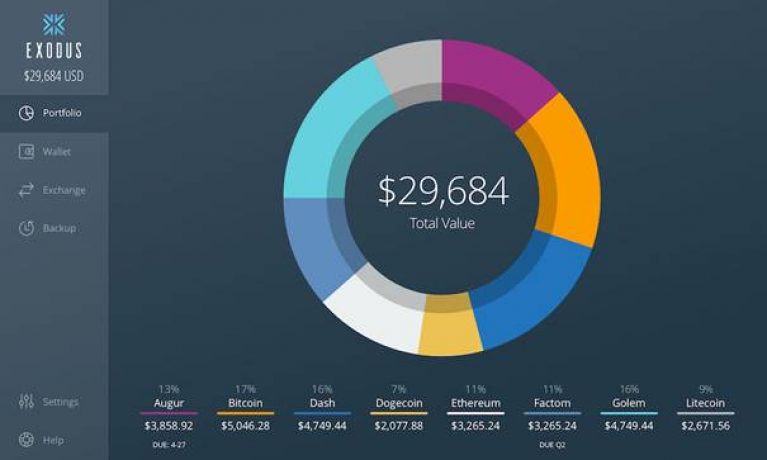
If you are looking for a Free LTC wallet, then you definitely have to try Exodus. This is also my favorite desktop wallet. This wallet has a really attractive User Interface, and is absolutely free to use and is extremely safe. The only drawback is that this wallet can only be used on a computer (Windows, Mac, and Linux). Exodus is a multi-currency desktop wallet that supports Litecoin, Bitcoin, Ethereum and other cryptos. It is backed by an active development team lead by JP Richardson and Daniel Castagnoli. I like the fact that Exodus’s ease of use isn’t compromised by a lack of security. You will get a 12-word seed key. The seed key would be needed if you want to restore/recover your wallet in case your computer gets damaged. For multi-cryptocurrency lovers, there is even an inbuilt ShapeShift converter, which you can use to exchange your cryptocurrencies instantly. It’s important to note that Exodus team is quite active and in case you face any issues, you would instantly get the solution.
5. Litecoin Core (Desktop Wallet)
Litecoin Core is the official Litecoin Wallet and being an official wallet, it is extremely safe to store your Litecoins. This wallet is absolutely free to use and is available on their website. Litecoin Core is a free to use desktop wallet, which means that if you start using it, your desktop will become your LTC wallet, and your private keys will be stored there on the desktop itself. And remember that core wallets sync with the entire blockchain, so this could take a lot of time (up to 4-5 days). It is now available for Linux, MAC, and Windows.
6. Rahakott – a new secure multi-currency wallet

Rahakott is a cryptocurrency wallet that allows anyone to send or receive digital currencies and to monitor their balance. You can use the wallet to monitor your balance online from anywhere. There is no need to log in to Rahakott with your e-mail address, telephone number or an username: you simply enter a mnemonic phrase. The system is also secured by two-factor authentication. You can also use Rahakott to create multiple wallets from a single account – for example, if you want to create sub-accounts for specific business relationships. Rahakott wallets are also “algoristic”, according to a study by NewsBTC. com, which means that for each transaction new addresses are generated to increase the anonymity of users. The Rahakott Wallet was introduced on November 12th 2017.
7. Loaf Wallet (Mobile Wallet)

Developed by Charlie Lee, the creator of LTC, Loaf Wallet is the first iOS-only mobile wallet for Litecoin. This wallet is backed by Litecoin Association, a passionate group of volunteers who want to promote LTC. It also has a group of active developers behind it. Loaf Wallet is simple to use and has a very clean interface. It also allows you to restore your funds by using a 12-word backup seed key. These features make it a great choice for beginners. It also has an inbuilt feature that allows its users to directly buy LTC from Coinbase instantly. This is a free wallet and is available only for iOS users on the Apple App Store!
8. Electrum-LTC (Desktop Wallet)

Electrum-LTC is also a Desktop wallet. However, it is a bit faster and lighter than Litecoin Core. Electrum-LTC is a lightweight Litecoin desktop wallet that does not sync the whole Blockchain thus you can start using it as soon as it is downloaded. It is a deterministic wallet providing its users a 12-word seed which makes sure that your funds are safe and secure. It is SegWit-enabled, and it provides another feature where you can ‘freeze‘ your funds i.e. no one can send the Litecoin from that address. However, I wouldn’t recommend this wallet at all for those who are new to cryptocurrency world, because it does not have a clean UI and looks too much techy. It is now available for Linux, Windows, and Mac OS X operating systems.
9. Liteaddress (Paper Wallet for Litecoin)
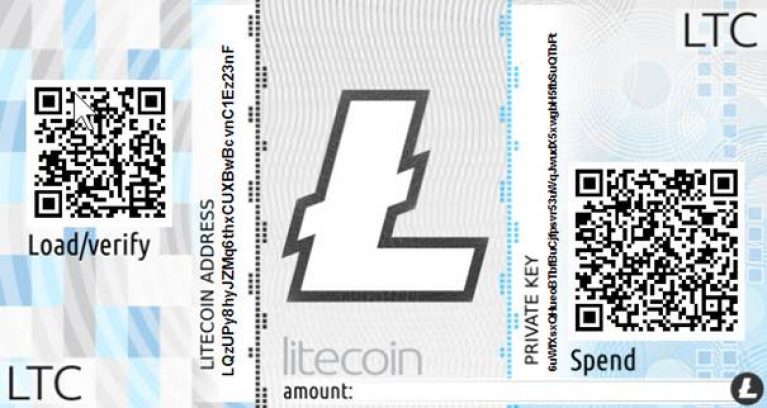
Litecoin Paper Wallet is perfect for those who have a large amount of Litecoins and want to store it for a longer period of time. If you are comfortable using paper wallets, you can make one at liteaddress.org. You can go this website and create your pair of private/public keys, and you need to store it in a very safe place. Unlike Hardware Wallets, Litecoin Paper Wallet is one of the safest and cheapest ways to store your Litecoins offline. However, if you don’t know how to properly handle a paper wallet, this can be tricky and a little bit risky.
Important Note: It’s highly recommended to make 2-3 copies of your Paper wallet and store them in a safe place.
So these were the Top 9 Best Wallets currently available in the market for storing litecoins.
Litecoin is almost 6 years old in the crypto world, and the future of Litecoin is quite bright and you must invest some of your funds into it for long term profits. It initially had a slow growth. However, after Charlie Lee’s return as a full developer, and also SegWit activation, Litecoin has had quite a good price rally. I am sure many users will be on the lookout for more wallet options for LTC. However, more choices will be available for each type of user as the technology matures. Until then, I will keep on trying out more Litecoin (LTC) wallets and add them to this list.
https://captainaltcoin.com/best-litecoin-wallets/
By: Felix Kuster

The cryptocurrency market has now been in a bear cycle for more than two-thirds of the past year, and, as August prepares to roll in September, predictions from past months that the bitcoin price would test its all-time high in 2018 appear less and less likely. However, even after this prolonged decline, Litecoin creator Charlie Lee says that the flagship cryptocurrency is still a good buy. Speaking with CNBC, Lee said that the drop off in prices has created an excellent investment opportunity for long-term bulls who have cash-in-hand that they can afford to lose.
"It's always good to buy on the way down to dollar-cost average your buy-in," he said. "As long as you don't spend money that you can't afford to lose, I think that's fine."
The former Google and Coinbase engineer cautioned against using borrowed funds to invest in bitcoin, a practice that became disturbingly common during last year’s fevered Q4 rally, noting that it’s incredibly difficult to predict short-term price movements and bear markets can in some cases endure for years. He said:
“It’s hard to predict prices. I’ve been in this space for seven years now. I think sometimes it comes back within six months to a year, and sometimes it takes three or four years.”
Lee further noted that, at present, cryptocurrency prices primarily reflect speculative interest, not actual consumer adoption. “It’s all about speculation these days, but, in the future, the price will reflect the success of the currencies,” he said, adding that there has been quite a bit of adoption this year even as prices have waned. However, when asked if he would be buying back into litecoin (he sold all his LTC back in December, citing a conflict of interest in having the ability to swap price movements with his public statements), Lee said no:
“I sold because of conflict of interest, so I’m not going to buy my litecoins back anytime soon — or at all.”
https://www.ccn.com/litecoin-creator-charlie-lee-recommends-buying-bitcoin-in-bear-market/
By: Bitcoin Analysis

Credit: Jinse.com
The Co-founder of Litecoin (LTC) has highlighted the motivations behind selling his LTC holdings, saying the media created sensational headlines out of a partial quote from him. Charlie Lee while revealing his statement at the just concluded LTC Summit, said he told the gathering the reasons behind selling his shares of LTC. He said:
“At the LTC Summit, I briefly addressed the motivation behind selling my LTC holdings. However, bad journalism is rampant in crypto, and now there’s a sensational headline created out of a partial quote from me.”
According to him, journalists picked up a quote from what he said half-jokingly and twisted it to gain cheap attention. “I said half-jokingly that it’s good that I did what I did or else I might need to find another job and can’t work full-time on Litecoin (not to mention help fund the Litecoin Foundation). Of course, that’s the only point this journalist picked up on and took no time to bash me.”
Speaking further, Charlie said he sold his LTC holdings to focus on adoption and not price. He, however, made known that he cherish Litecoin and does not require monetary incentives. He highlighted: “re: conflict of interest, I sold my LTC holdings so I could focus on adoption and not price, as those 2 are not always correlated. Litecoin is my baby, so I don’t need monetary incentive to want it to succeed.”
Charlie, whose advice to the cryptocurrency community has always be 'to HODL' revealed to the crypto world that he has not contradicted his advice, saying selling during a bull market does not contradict the advice of hodling. “Finally, a bit about hodling. The term came from a bitcointalk forum user who refused to sell when the market is crashing. To hodl means to not panic sell when prices are down. Selling during a bull market does not contradict the advice of hodling.”
Charlie Lee said December 2017 on Reddit that he sold and donated all of his Litecoin tokens few weeks back. He did this at a time the price of LTC was over $300. The move generated and continues to generate series of accusations within the crypto space. On this decision, according to him, “some people even think I short LTC (litecoin)!”.
https://ethereumworldnews.com/litecoins-charlie-lee-highlights-motivations-behind-selling-his-ltc-holdings/
By: Yusuff Olayode Supoto